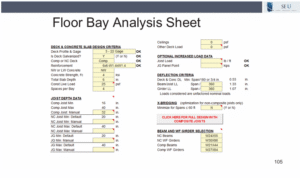SJI Comparison Tool: Composite vs. Non-Composite Joists
Are you aware of the many advantages of using open web steel joists to achieve a high performance floor? In many cases, steel joists are an economical solution to reduce the overall steel weight, reduce floor-to-floor heights, reduce costs, and produce a flatter finished floor with improved vibration characteristics. In the past, engineers have faced vibration issues using open web steel joists, due to the lighter overall floor system, however, improvements in design and construction techniques have leveraged the advantages of steel joists to produce an economical and better performing building structure.
In the August 2025 SEU session, Joe Pote, PE, from New Millennium, and Dave Samuelson, PE, retired from Nucor, presented Composite Floor Joist Systems. Joe and Dave explained what spacings and depths work best for open web steel joists in floors and how to decrease the floor-to-floor height while increasing the joist depth. They also discussed the advantages of flush-frame joist connections in floor construction. Joe and Dave shared a useful new tool which compares the performance and costs of different steel framing options which is now available through the Steel Joist Institute (SJI).
Available as a free download from SJI, the Floor Bay Comparison Tool – With Vibration can be used to analyze composite and non-composite systems composed of joists and joist girders or hot-rolled steel sections. The tool also does a vibration analysis and allows the user to compare options to improve the vibration performance of the floor bay. As you can see below, the user must specify the geometry of the bay, as well as loading conditions, deck and slab selection, deflection criteria, and depths of the joists, beams or girders.
To understand the specifics of this tool, the user should first read the Gen Info sheet which answers many FAQs and provided references, and then review the User Notes which explains recommendations, including many related to improving vibration performance. After the floor bay has been analyzed, the user is provided with comparison tables noting the lightest option, peak acceleration ratios, natural frequencies and limit checks are listed and compared, including options for different joist seat depths or flush mounted joists, which can significantly reduce vibrations. The user can then make educated selections for joists or beams, composite or non-composite, to achieve desired floor-to-ceiling heights while reducing overall weight and minimizing vibrations.
SJI provides a number of other design tools which are available as free downloads at their website. Check out these free tools on your next project using joists and joist girders to save valuable design time and lower costs. Another excellent resource is SJI’s Technical Digest 13 – Specification and Design of Composite Steel Joists which includes the design methodology of CJ-Series Composite joists and can be purchased from SJI for use in conjunction with the Second Edition CJ-Series Composite Steel Joists catalog, which is available as a free download.



There are no comments yet, but you can be the first